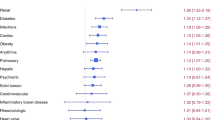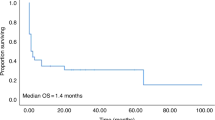Abstract
Comorbidities affect clinical outcomes and costs in medicine. The hematopoietic cell transplantation (HCT)-specific comorbidity index (HCT-CI) predicts mortality risk after HCT. Its association with resource utilization (RU) is unknown. In this single-center, retrospective study, we examined the association of HCT-CI with RU (readmissions, length of hospital stay (LOS) and days out of hospital alive (DOHA)) in first 100 days (n=328) and 1 year (n=226) in allogeneic HCT patients from January 2010 to June 2014. Age, disease risk, conditioning and use of antithymocyte globulin were significantly different in the four groups with HCT-CI 0 to1 (n=138), 2 (n=56), 3 (n=55) or ⩾4 (n=79). Although the readmissions were higher in the first 100 days for patients with HCT-CI >0–1 (P=0.03), they were not significantly different in patients over 1 year (P=0.13). In the multivariable analysis, patients with HCT-CI score of >0 to 1 had increased LOS and fewer DOHA in both 100 days and 1 year after HCT. In this exploratory analysis, we found that HCT-CI >0 to 1 is associated with increased RU after allogeneic HCT. Recognizing predictors of RU can identify patients at risk of high utilization and help understand what drives health-care costs.
This is a preview of subscription content, access via your institution
Access options
Subscribe to this journal
Receive 12 print issues and online access
$259.00 per year
only $21.58 per issue
Buy this article
- Purchase on Springer Link
- Instant access to full article PDF
Prices may be subject to local taxes which are calculated during checkout


Similar content being viewed by others
References
Khera N, Zeliadt SB, Lee SJ . Economics of hematopoietic cell transplantation. Blood 2012; 120: 1545–1551.
Shulman DS, London WB, Guo D, Duncan CN, Lehmann LE . Incidence and causes of hospital readmission in pediatric patients after hematopoietic cell transplantation. Biol Blood Marrow Transplant 2015; 21: 913–919.
Spring L, Li S, Soiffer RJ, Antin JH, Alyea Iii EP, Glotzbecker B . risk factors for readmission after allogeneic hematopoietic stem cell transplantation and impact on overall survival. Biol Blood Marrow Transplant 2015; 21: 509–516.
Lee SJ, Klar N, Weeks JC, Antin JH . Predicting costs of stem-cell transplantation. J Clin Oncol 2000; 18: 64–71.
Saito AM, Zahrieh D, Cutler C, Ho VT, Antin JH, Soiffer RJ et al. Lower costs associated with hematopoietic cell transplantation using reduced intensity vs high-dose regimens for hematological malignancy. Bone Marrow Transplant 2007; 40: 209–217.
Kline RM, Meiman S, Tarantino MD, Herzig RH, Bertolone SJ Jr . A detailed analysis of charges for hematopoietic stem cell transplantation at a children's hospital. Bone Marrow Transplant 1998; 21: 195–203.
Griffiths RI, Bass EB, Powe NR, Anderson GF, Goodman S, Wingard JR . Factors influencing third party payer costs for allogeneic BMT. Bone Marrow Transplant 1993; 12: 43–48.
Khera N, Emmert A, Storer BE, Sandmaier BM, Alyea EP, Lee SJ . Costs of allogeneic hematopoietic cell transplantation using reduced intensity conditioning regimens. Oncologist 2014; 19: 639–644.
Lee SJ, Zahrieh D, Alyea EP, Weller E, Ho VT, Antin JH et al. Comparison of T-cell-depleted and non-T-cell-depleted unrelated donor transplantation for hematologic diseases: clinical outcomes, quality of life, and costs. Blood 2002; 100: 2697–2702.
Lin YF, Lairson DR, Chan W, Du XL, Leung KS, Kennedy-Nasser AA et al. The costs and cost-effectiveness of allogeneic peripheral blood stem cell transplantation versus bone marrow transplantation in pediatric patients with acute leukemia. Biol Blood Marrow Transplant 2010; 16: 1272–1281.
Majhail NS, Mothukuri JM, Macmillan ML, Verneris MR, Orchard PJ, Wagner JE et al. Costs of pediatric allogeneic hematopoietic-cell transplantation. Pediatr Blood Cancer 2010; 54: 138–143.
El-Jawahri A, Chen Y-B, Brazauskas R, He N, Lee SJ, Knight JM et al. Impact of pre-transplant depression on outcomes of allogeneic and autologous hematopoietic stem cell transplantation. Cancer (e-pub ahead of print 19 January 2017; doi:10.1002/cncr.30546).
Sorror ML, Maris MB, Storb R, Baron F, Sandmaier BM, Maloney DG et al. Hematopoietic cell transplantation (HCT)-specific comorbidity index: a new tool for risk assessment before allogeneic HCT. Blood 2005; 106: 2912–2919.
Sorror M, Storer B, Sandmaier BM, Maloney DG, Chauncey TR, Langston A et al. Hematopoietic cell transplantation-comorbidity index and Karnofsky performance status are independent predictors of morbidity and mortality after allogeneic nonmyeloablative hematopoietic cell transplantation. Cancer 2008; 112: 1992–2001.
Bayraktar UD, Shpall EJ, Liu P, Ciurea SO, Rondon G, de Lima M et al. Hematopoietic cell transplantation–specific comorbidity index predicts inpatient mortality and survival in patients who received allogeneic transplantation admitted to the intensive care unit. J Clin Oncol 2013; 31: 4207–4214.
Charlson ME, Charlson RE, Peterson JC, Marinopoulos SS, Briggs WM, Hollenberg JP . The Charlson comorbidity index is adapted to predict costs of chronic disease in primary care patients. J Clin Epidemiol 2008; 61: 1234–1240.
Hollenbeak CS, Stack BC Jr., Daley SM, Piccirillo JF . Using comorbidity indexes to predict costs for head and neck cancer. Arch Otolaryngol Head Neck Surg 2007; 133: 24–27.
Starfield B, Lemke KW, Herbert R, Pavlovich WD, Anderson G . Comorbidity and the use of primary care and specialist care in the elderly. Ann Fam Med 2005; 3: 215–222.
Landi F, Onder G, Cesari M, Barillaro C, Lattanzio F, Carbonin PU et al. Comorbidity and social factors predicted hospitalization in frail elderly patients. J Clin Epidemiol 2004; 57: 832–836.
Ariti CA, Cleland JG, Pocock SJ, Pfeffer MA, Swedberg K, Granger CB et al. Days alive and out of hospital and the patient journey in patients with heart failure: Insights from the candesartan in heart failure: assessment of reduction in mortality and morbidity (CHARM) program. Am Heart J 2011; 162: 900–906.
Armand P, Gibson CJ, Cutler C, Ho VT, Koreth J, Alyea EP et al. A disease risk index for patients undergoing allogeneic stem cell transplantation. Blood 2012; 120: 905–913.
Stranges E, Russo CA, Friedman B . Procedures with the Most Rapidly Increasing Hospital Costs, 2004–2007. HCUP Statistical Brief #82. Agency for Healthcare Research and Quality: Rockville, MD, USA, 2009.
Lee SJ, Anasetti C, Kuntz KM, Patten J, Antin JH, Weeks JC . The costs and cost-effectiveness of unrelated donor bone marrow transplantation for chronic phase chronic myelogenous leukemia. Blood 1998; 92: 4047–4052.
Majhail NS, Mothukuri JM, Brunstein CG, Weisdorf DJ . Costs of hematopoietic cell transplantation: comparison of umbilical cord blood and matched related donor transplantation and the impact of posttransplant complications. Biol Blood Marrow Transplant 2009; 15: 564–573.
Sorror ML, Martin PJ, Storb RF, Bhatia S, Maziarz RT, Pulsipher MA et al. Pretransplant comorbidities predict severity of acute graft-versus-host disease and subsequent mortality. Blood 2014; 124: 287–295.
Lee WC, Arcona S, Thomas SK, Wang Q, Hoffmann MS, Pashos CL . Effect of comorbidities on medical care use and cost among refractory patients with partial seizure disorder. Epilepsy Behav 2005; 7: 123–126.
Hagenmeyer EG, Haussler B, Hempel E, Grannas G, Kalo Z, Kilburg A et al. Resource use and treatment costs after kidney transplantation: impact of demographic factors, comorbidities, and complications. Transplantation 2004; 77: 1545–1550.
Stewart S, Wiley JF, Ball J, Chan Y-K, Ahamed Y, Thompson DR et al. Impact of nurse-led, multidisciplinary home-based intervention on event-free survival across the spectrum of chronic heart disease: composite analysis of health outcomes in 1226 patients from 3 randomized trials. Circulation 2016; 133: 1867–1877.
Boriani G, Berti E, Belotti LMB, Biffi M, De Palma R, Malavasi VL et al. Cardiac device therapy in patients with left ventricular dysfunction and heart failure: ‘real-world’ data on long-term outcomes (mortality, hospitalizations, days alive and out of hospital). Eur J Heart Fail 2016; 18: 693–702.
Hasan O, Meltzer DO, Shaykevich SA, Bell CM, Kaboli PJ, Auerbach AD et al. Hospital readmission in general medicine patients: a prediction model. J Gen Intern Med 2010; 25: 211–219.
Bejanyan N, Bolwell BJ, Lazaryan A, Rybicki L, Tench S, Duong H et al. Risk factors for 30-day hospital readmission following myeloablative allogeneic hematopoietic cell transplantation (allo-HCT). Biol Blood Marrow Transplant 2012; 18: 874–880.
Cordonnier C, Maury S, Esperou H, Pautas C, Beaune J, Rodet M et al. Do minitransplants have minicosts? A cost comparison between myeloablative and nonmyeloablative allogeneic stem cell transplant in patients with acute myeloid leukemia. Bone Marrow Transplant 2005; 36: 649–654.
Khera N, Emmert A, Storer BE, Sandmaier BM, Alyea EP, Lee SJ . Costs of allogeneic hematopoietic cell transplantation using reduced intensity conditioning regimens. Oncologist 2014; 19: 639–644.
Petersen SL, Madsen HO, Ryder LP, Svejgaard A, Jakobsen BK, Sengeløv H et al. Haematopoietic stem cell transplantation with non-myeloablative conditioning in the outpatient setting: results, complications and admission requirements in a single institution. Br J Haematol 2004; 125: 225–231.
Deeg H, Steuten LM . Therapy for hematologic cancers in older patients, quality of life, and health economics: Difficult decisions. JAMA Oncol 2015; 1: 571–572.
Author information
Authors and Affiliations
Corresponding author
Ethics declarations
Competing interests
The authors declare no conflict of interest.
Rights and permissions
About this article
Cite this article
Decook, L., Chang, YH., Slack, J. et al. Association of hematopoietic cell transplantation-specific comorbidity index with resource utilization after allogeneic transplantation. Bone Marrow Transplant 52, 998–1002 (2017). https://doi.org/10.1038/bmt.2017.70
Received:
Revised:
Accepted:
Published:
Issue Date:
DOI: https://doi.org/10.1038/bmt.2017.70



